Mobile gaming, that is playing games on your mobile phone, is growing rapidly. Advances in phones, displays and networks mean that the handset in your jacket pocket is a considerably more powerful games console than that NES you sat in front of just a few years ago playing Mario Kart. In fact, phones have grown in sophistication so quickly that it’s quite shocking to think that just five years ago our most immersive mobile gaming experience was a quick bout of Snake.
The success of mobile gaming can attributed to Java – Sun’s environment means that games can be written in Java and will run on any phone that has a J2ME (Java 2, Micro Edition) virtual machine embedded in its operating system.
Additionally, Gamers are now used to seeing graphics made out of millions of polygons on their GameCubes and PlayStation 2s and expect the same thing from their mobile gaming. Memory and processor advances now mean that games developers can now meet this demand, and so the JSR184 standard (now known as M3G) came into being, to provide a platform for developers to produce immersive 3D games.
As phones incorporate more memory, faster processors, dedicated graphics chips, stereo sound and 3D graphics, it means that games too require more resources to produce. As the games get more complex they require a multi-disciplined approach, with artists, coders, level designers and musicians all contributing to the final product.
This rapid increase in sophistication means that it’s now impossible to produce a decent game for modern phones without a suite of development tools, and as 3D graphics creep out onto our phones, tools are appearing that deal specifically with the unique problems of throwing around shaded, textured polygons on tiny screens with limited resources.
A new breed of tools, specifically designed to enable developers to squeeze the best performance out of M3G is appearing, and you’ll be playing games created with these tools on your phone in the very near future.
I had a chat with Stephan Groud from Superscape – one of the companies behind the M3G standard – and product manager for the first 3D toolkit for mobile phones, Swerve. We talked about the benefits of 3D and what’s up next for mobile phone gaming.
Tell me a little how Superscape got into 3D on phones, and how Swerve came into being.
Superscape is 3D company – we’ve done 3D for 18 years now. We’ve always worked in the 3D field, either around 3D games or tools. In short, the company has always been focussed on 3D for low processing power or low bandwidth.
We looked at the mobile market and decided that we had the expertise to take our experience and provide 3D for constrained devices and constrained networks, which is exactly what the mobile market is about.
We set out to develop this technology, Swerve, which is basically suited for 3D on mobile devices. To make it a success, we went to companies like ARM and Vodaphone – and came to the conclusion that unless there was a standard to do 3D on mobile phones, then it wouldn’t be a viable proposition.
We then went to Nokia and Sun and helped set up the JSR 184 standard, which basically states how you do 3D, in Java, on a mobile phone. The exact remit of the standard was to deliver 3D experiences on mobile platforms, over the air. The standard had to be generic enough to do not only games, but menus, user interfaces and potentially location-based services. It also needed to be a standard that could output content small enough to downloaded over the air.
The standard was ratified in November 2003, and since Swerve had been in the making for about three years, it was the first commercial implementation of that standard, both in terms of engine and tools.
What exactly is the Swerve platform?
The Swerve solution is an engine, compliant with JSR 184, that sits on your phone, within the Java architecture. We worked with companies such as Siemens and Motorola to embed our technology in handsets to make them JSR 184 compliant, or M3G compliant which is the new name for the standard. A M3G phone can run any JSR184 piece of content.
On top of releasing the engine on the day the standard was ratified, we announced the second generation of our tools, SwerveStudio. This allows you to export 3D scenes from 3dsMax – we took the most popular 3D package and built in every function that would be required to author or develop content for the M3G platform, without having to recreate everything from scratch. If you know 3dsMax and you have an understanding of the M3G API, you can use SwerveStudio because it’s basically the same thing, but with tools for optimising the scene for mobile phones, to preview the scene as it would look on a handset, to script behaviours, and to export the scene as a M3G file.
If you have SwerveStudio and you have 3dsMax you have an environment that allows you to create a good chunk of what a game is. The rest is done by a coder through a regular Java IDE [integrated development environment].
By integrating your toolkit in 3dsMax and using the Java VM on phones, that gives you a huge installed base of artists and coders that can use Swerve straight away – and a huge installed base of consumers that can run the content.
We’re working with mobile phone manufacturers to get the M3G API embedded onto handsets shipped from this summer onwards.
We’re not the only people to come up with a product based on the M3G standard, and there are other people announcing phones and tools based upon it, so that’s basically growing the market for games that are based on our tools.
What are the main titles coming out that use Swerve?
We realised quickly that it was all well and good to have a tool set, but the manufacturers and operators want games. What we’ve done over the past six to eight months is to create a catalogue of games – and most of those games are based on famous intellectual properties from Sony, Disney and 20th Century Fox, Universal, and Activision. We either developed those games in house or worked with external developers. The games are Independence Day, based on the 20th Cenutry Fox movie; Van Helsing, Universal’s blockbuster this summer; SWAT from Sony Pictures; and Evel Knievel – we have the rights for mobile platforms to develop games based on his brand; we’re working with Disney on TRON2.0, which will be focussed on Light Cycles, so we’re not cramming too much into a game that has to be downloaded over the air.
Big brands, big studios, big companies are all working with us because they’ve had a look at our technology and said “Hey, this is the best way to take our brand into the mobile space.”
M3G as a technology gives a truer representation of your brand. If you look at other technologies, even 2D, it’s sometimes difficult to recognise the brand you’re using.
We’re working with the guys behind the brands and studios to improve our tools, improve the engine and tackling IP holders, game developers, network operators, handset manufacturers and technology guys to make sure the whole system works together.
When will the first Swerve-developed titles be available for download?
That’ll be with the release of the first M3G handsets, in Q3 2004.
What do you think of handsets like the N-Gage QD that use dedicated games on memory cards, and attempt to be more of a games console rather than a phone? Do you think they’re a kind of stopgap, or that this will be a common way for distributing titles?
There are two ways to do mobile 3D games. One way is the N-Gage route, which is basically native games, megabytes of data, you buy a cartridge in a shop and you plug it into your handset. That’s something that has been proven in the past with the GameBoy and GameBoy Advance, there’s clearly a market for it. Whether there is room for a mobile phone player to create a market for it is another question.
The other way is what M3G is exactly about: It’s not native, it’s Java with none of the benefits of native because the engine is partly Java, partly native to keep performance up. It’s sub-250 kilobyte games, to be downloadable over the air, and you don’t have to go into a shop and buy it. You can be on a train or a taxi, you didn’t know you wanted to play a game, but you’ve got fifteen minutes in front of you and no newspaper at hand. You can download a game on impulse.
These are two very different propositions. If you’re talking about platforms like the N-Gage right now, the volumes are fairly limited, because of the price point, because of the market it targets, as opposed to Java handsets – there are going to be millions of those over the coming years. Java handsets are a cheaper proposition and are more accessible. A handset can have the M3G API embedded in it and still look like a professional handset.
We’ve chosen the M3G way because we believe that mobile handsets are inherently connected devices and, in the same way that add-on camera accessories for handsets never took off, potentially the same thing could happen to platforms like the N-Gage. If you have to think about what you’re going to be doing with the phone over the day, you lose the immediate satisfaction of downloading a game on impulse and being able to play it.
What N-Gage has done though, is to put mobile gaming on the map for a lot of people. Nokia is a big company and the fact that they’ve pushed this platform so much and invested so much money in it has raised a few heads around the industry and also around the console industry.
Our proposition is downloadable content and we’re sticking to that right now, because our technology can do it.
What’s next for Swerve?
We’ll be looking at how well customers react to 3D on mobile phones, and looking at the uplift that 3D on phones causes, in the same way that 3D on consoles caused such a big market.
We’ll also be growing the catalogue of games that we have in house, or that we develop with partners. We have about 25 right now – we’re going to need a lot more than that when there are several different handsets in the market.
Also, Swerve as a 3D technology can also run in BREW and native environments, as well as J2ME. Swerve BREW applications can be run on BREW handsets such as the recently announced Kyocera Koi, thanks to a downloadable BREW extension provided by Superscape to BREW network operators. Swerve Native applications can run on the same engine as Swerve J2ME applications as it is a dual language 3D engine. This makes the business case for embedding the engine on an upcoming handset even more attractive, especially as Swerve is a generic 3D engine.
The next challenge will be hardware graphics acceleration, and the M3G standard was built with hardware acceleration in mind. The hardware acceleration does the grunt work in terms of rendering polygons, shading and anti-aliasing and M3G gives the developers a nice API to work with to develop games quickly.
M3G is a high level API, with a scene tree with nodes for each object in the scene – what that means for an animator or a programmer that you move a car or an actor rather than move every single polygon that makes up the car. It’s object based.
M3G has a long life in front of itself, even when hardware acceleration comes along because it gives an entry point for developers and designers that is very easy to use without losing the benefits of hardware acceleration.
What do you think are the most important types of game for mobile phones? Will the connectivity change the types of games people play?
We’re developing a variety of games, single player games. Given the interface on mobile phones, we have racing games, first person shooters, sports games. These are quite well-suited because most handsets today have some form of joystick so it’s quite easy to navigate a car around.
In terms of multiplayer, you have to be concious that networks have latency and so turn-based games are the ideal target for the moment. Golf is a great example of a game that is quite interactive and visual, benefits from being in 3D and at the same time is simple to implement in multiplayer because you can actually play in turns.
I suppose bandwidth is less of an issue with golf because you’re only transmitting a vector?
The interesting thing with golf in 3D is that if you both have the same game and you’re playing with each other you don’t have to send that much data across the network because you’re not replicating that much data: the power of the shot, the swing. The game engine can understand this and replay it like a movie on your opponent’s handset.
There are a lot of tricks with 3D implementations of games, like being able to download new levels, new guns that we’re looking at also.
Do you think there is much of a market for selling add-ons to games like levels, skins and equipment?
If you look at ringtones and wallpapers, well who would have thought that people would be willing to pay millions of dollars to just have a different ringing sound on their phone?
We hope there is a market for game add-ons, and it depends on the way that a campaign is organised. In Formula One, for example a developer could release a game on the first day of the season, with the first track — and subsequently produce new tracks for every race available for download.
This makes a lot of sense because they can charge a little for each new track, but in terms of network usage it’s nothing. The data they need to send to recreate a new 3D track if the game is well built is minimal. The less data they send over the network, the better it is for them economically. The value for the user is extreme, because they have a new track and they can actually play the race that’s being run that weekend.
It’s a whole industry in the making!
3D brings a lot more. If you need to send a 2D track, then you’re in for a big download. You’re looking at sprites as opposed to rearranging pieces of track. You can have green trees in England and yellow trees in Spain, but in 3D it’s the same tree, it’s already on the phone – you’re just saying “this.tree = yellow”, rather than downloading an image of a new tree.
We’re learning every day – it’s exciting times. When you think about convergence, this really gives some meaning to the word: you have people from the PC world, such as developers, hardware and 3D guys, mobile phone operators, cinema studios – everybody is coming together.
It does seem that you need many different skills to produce a game these days – you need proper artists, programmers, musicians, you need to get the intellectual property from somewhere…
It’s not easy, but the results are quite impressive!
The JSR 184 Standard
Swerve
Superscape
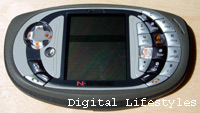 Nokia have admitted that their first attempt at a games console didn’t exactly set the world on fire: it had a number of design problems and they misjudged market desires – and failed to take into account just why Nintendo have had a 15 year reign on mobile gaming. But with new features, a greater emphasis on networked play and the GameBoy Advance looking a little basic these days, have they got it right this time?
Nokia have admitted that their first attempt at a games console didn’t exactly set the world on fire: it had a number of design problems and they misjudged market desires – and failed to take into account just why Nintendo have had a 15 year reign on mobile gaming. But with new features, a greater emphasis on networked play and the GameBoy Advance looking a little basic these days, have they got it right this time? The deck is well constructed, and despite its compactness it has a reassuring weight to it (143g), without being awkward. It’s one of the most robustly-made phones I’ve used. The equator of the unit is a protruding rubber seal, and will generally be the first thing to hit the floor when you drop it, thus providing a fair bit of impact shock protection. The seal clips neatly over the phone’s ports limiting sand and water penetration, but doesn’t make it waterproof. External connections are limited to just headphones, power, and the game slot. All communications with the N-Gage are done via Bluetooth. The rubber equator also features no less than two loops for connecting a lanyard to – a quick look at any bus stop will demonstrate that youths like nothing more at the moment than hanging things like keys and phones round their neck with a lanyard. Or they do in Blackheath anyway.
The deck is well constructed, and despite its compactness it has a reassuring weight to it (143g), without being awkward. It’s one of the most robustly-made phones I’ve used. The equator of the unit is a protruding rubber seal, and will generally be the first thing to hit the floor when you drop it, thus providing a fair bit of impact shock protection. The seal clips neatly over the phone’s ports limiting sand and water penetration, but doesn’t make it waterproof. External connections are limited to just headphones, power, and the game slot. All communications with the N-Gage are done via Bluetooth. The rubber equator also features no less than two loops for connecting a lanyard to – a quick look at any bus stop will demonstrate that youths like nothing more at the moment than hanging things like keys and phones round their neck with a lanyard. Or they do in Blackheath anyway. Using the unit as a phone has been vastly improved – you now hold the unit flush to your cheek, rather than holding it out at an angle, as was the case with its previous incarnation. Sadly, the unit’s display rests against your face when you make a call. If you wear make up or use the phone on a warm day, be sure to carry a cloth so you can wipe sweat and foundation off the screen. Lack of exterior controls for volume mean you can’t easily adjust call loudness if you’re suddenly in a noisy or quite environment.
Using the unit as a phone has been vastly improved – you now hold the unit flush to your cheek, rather than holding it out at an angle, as was the case with its previous incarnation. Sadly, the unit’s display rests against your face when you make a call. If you wear make up or use the phone on a warm day, be sure to carry a cloth so you can wipe sweat and foundation off the screen. Lack of exterior controls for volume mean you can’t easily adjust call loudness if you’re suddenly in a noisy or quite environment.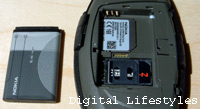 The 4096-colour display is difficult to read if the backlight isn’t on, but battery life in the QD is impressive. Nokia claim a full ten hours of gaming off a charge, up from about three to six hours previously. I charged the phone on Tuesday morning and only needed to give it a drink again on Thursday, after leaving it on continuously with my normal number of phone calls, texts and a few bouts of The Sims. As a side note, it accepts the standard Nokia charger and I can’t think of a household that hasn’t got four of those kicking around somewhere.
The 4096-colour display is difficult to read if the backlight isn’t on, but battery life in the QD is impressive. Nokia claim a full ten hours of gaming off a charge, up from about three to six hours previously. I charged the phone on Tuesday morning and only needed to give it a drink again on Thursday, after leaving it on continuously with my normal number of phone calls, texts and a few bouts of The Sims. As a side note, it accepts the standard Nokia charger and I can’t think of a household that hasn’t got four of those kicking around somewhere.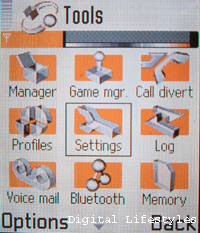 The interfaces for the phone and the game functions were evidently designed by two different teams. Two different teams in different countries. Who never spoke to each other or exchanged emails, or perhaps were even completely unaware of each others’ existence. The N-Gage Arena and gaming interfaces are much more compelling and excitingly designed, showing that Nokia have put a lot of thought into their appearance.
The interfaces for the phone and the game functions were evidently designed by two different teams. Two different teams in different countries. Who never spoke to each other or exchanged emails, or perhaps were even completely unaware of each others’ existence. The N-Gage Arena and gaming interfaces are much more compelling and excitingly designed, showing that Nokia have put a lot of thought into their appearance. All the usual messaging functions are present: SMS, Multimedia Messaging, and email. I did come across an irritating feature whilst texting, however: pressing the uppercase key a couple of times whilst writing a text message (for the odd bit of EMPHASIS) turns the T9 dictionary off for some reason. This is highly annoying and requires six or seven button presses to switch it back on and then another six or so to get back to where you were. I do hope this is a bug rather than a deliberate feature.
All the usual messaging functions are present: SMS, Multimedia Messaging, and email. I did come across an irritating feature whilst texting, however: pressing the uppercase key a couple of times whilst writing a text message (for the odd bit of EMPHASIS) turns the T9 dictionary off for some reason. This is highly annoying and requires six or seven button presses to switch it back on and then another six or so to get back to where you were. I do hope this is a bug rather than a deliberate feature.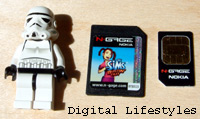 Games are supplied on a MMC card, and the QD is backwardly compatible with its predecessor. The moving of the game slot to the bottom of the console is a welcome move, so you don’t have to take the back off the unit to swap games over. Nokia seem to have realised that people might want to play more than one game in a session.
Games are supplied on a MMC card, and the QD is backwardly compatible with its predecessor. The moving of the game slot to the bottom of the console is a welcome move, so you don’t have to take the back off the unit to swap games over. Nokia seem to have realised that people might want to play more than one game in a session.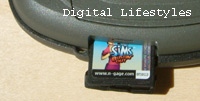 Despite not having a camera, the QD will play video clips and other multimedia messaging, however there’s no radio and something key has been removed from this iteration of the N-Gage.
Despite not having a camera, the QD will play video clips and other multimedia messaging, however there’s no radio and something key has been removed from this iteration of the N-Gage.